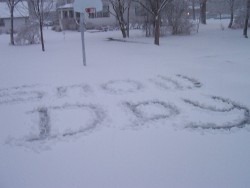It is a Snow Day. School has been canceled. It has been snowing all night. There is about a foot of snow on the ground. It is that heavy wet snow not that light fluffy powder so prized by skiers. This stuff weighs a ton when you pick it up by the shovel full.
Alice has finally finished shoveling her driveway and she is ready to go to work. It took her about an hour but the job is finally done.
Later that night Alice notices that her back muscles are really sore and tense. She is feeling really stiff and tight in her back. There has been the occasional tinge from her back muscles as well.
Alice has overworked her back muscles with all of that snow shoveling that she did in the morning.
What is the problem with Alice’s back
Shoveling snow is an injury prone activity. It puts a lot of pressure on your lower back muscles.
Bent over
First of all when you shovel snow you are bent over. You bend over to pickup the snow with your snow shovel. This bending over puts a lot of stress into the muscles of your lower back. Our sedentary life style has allowed these muscles to become weak and not ready for the hard work of shoveling snow.
Twisting
Throwing the snow to the side to get it out of the way is another problem. This involves twisting the spine to one side or the other depending on your driveway. You may be able to throw the snow only to one side. This twisting movement to one side or both sides results in more muscles in the lower back getting overused and stressed.
If the snow is the heavy wet stuff like it was for Alice then there is even more weight being lifted with each shovel full. This puts even more stress into her lower back muscles.
Why is this a problem
Alice leads a fairly active life style and she has been doing yoga for a while now, but shoveling snow for an hour or so is a very different activity. The muscles in her lower back are not ready for this amount of heavy exercise over such an extended period of time.
Now Alice’s muscles are complaining about being overworked. They have tensed up in an effort to protect themselves from injury. As a result Alice’s back is stiff and sore, but there is something that Alice can do to relieve this discomfort.
How to fix the muscles in Alice’s back with yoga
There are several yoga poses that Alice can use to relieve the tension in her lower back muscles. These particular yoga poses allow Alice to stretch her lower back muscles gradually and with care.
Pashimottanasana
This is a seated forward fold. Alice can fold forward and gradually stretch the muscles in her lower back. The feedback from her back muscles will guide her as she slowly stretches the muscles and deepens the forward fold.
Marichyasana C
This is a seated twist of the spine. First Alice can twist one way and then the other. Again with this pose she can gradually stretch the muscles in the lower back.
Using the feedback from the muscles in her back Alice can gradually increase the amount of twist that she is applying. She will probably find that the muscles are more tense on one side compared to the other. The more tense side is the same side that she threw most of the snow to.
Uttanasana
This is a standing forward fold. Alice should only attempt this pose if she can rest her hands on the floor. If her hands do not reach the floor then this pose could cause further injury to her back muscles.
This standing pose will gradually stretch and lengthen the spine, increasing the space between the vertebrae.
Again Alice listens to the feedback from her muscles to determine how far to go into the pose and how quickly or slowly to move further into the pose.
These poses have a couple of important features in common.
- All of these poses let you gradually stretch the muscles in your back.
- You can enter into the pose slowly.
- You are not using your back muscles to support you in the pose.
- You are able to stay in the pose for an extended period of time.
As Alice enters these poses she uses the feedback from her muscles to determine how far she should go with her stretching. Her muscles will tell her when to stop and hold the stretch and then they will tell her when they are ready to move a little bit further into the stretch.
Alice is careful to use the feedback from her muscles to avoid injuring her muscles further.
How do I know if I should do yoga to help my back muscles?
Sometimes when you are shoveling snow you can cause serious injury to your back muscles.
When you have sharp pain or muscle spasms in your back muscles, then yoga is not going to help you and you need to see your health care professional.
If when you attempt one of the yoga poses mentioned above you feel sharp pain or severe discomfort right away then you need to stop and see your health care professional as well.
If however when you attempt these yoga poses you feel a delicious stretch and the muscles start to relax and lengthen then the yoga poses are helping and you can continue with the stretching.
Summary
Alice did the right thing. She worked with her yoga teacher to find the right yoga poses to help to relieve the tension and tightness in her lower back muscles.
Next steps
The next time there is lots of snow to be shoveled, Alice should consider a couple of alternatives:
- Replace the snow shovel with a scoop and push the snow out of the way rather than lifting and throwing it.
- Get a couple of neighborhood kids to shovel the snow for her.
- Hire a snow clearing service.
Her back will be glad that she did.





